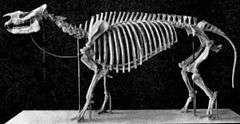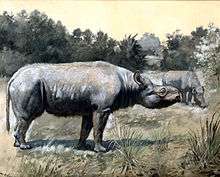Subhyracodon
| Subhyracodon Temporal range: Late Eocene–Late Oligocene | |
|---|---|
 | |
| Subhyracodon occidentalis skeleton | |
| Scientific classification | |
| Kingdom: | Animalia |
| Phylum: | Chordata |
| Class: | Mammalia |
| Order: | Perissodactyla |
| Family: | Rhinocerotidae |
| Genus: | †Subhyracodon (Brandt, 1878) |
| Type species | |
| †Rhinoceros occidentalis | |
| Species[2] | |
| |
| Synonyms | |
Subhyracodon is an extinct genus of cow-sized rhinoceroses. With a length of 2.4 m (8 ft) and a weight estimated of 381.3 kg (in S. mitis), it was a tapir-sized herbivore on the plains of early Oligocene South Dakota 33 million years ago (White River Fauna), smaller than only the Brontops and the chalicotheres.[5] Subhyracodon had no horns, relying more on its speed to escape, but a species found at Wind Cave National Park had a pair of bony nasal ridges. The genera Caenopus and Aceratherium were both synonymized with Subhyracodon[6]

Life restoration by Charles R. Knight
Skull
See also
References
- ↑ Prothero, 2005, p. 41.
- ↑ Prothero, 2005, pp. 40-47.
- ↑ McKenna & Bell, 1997, p. 481.
- 1 2 3 Prothero, 2005, p. 43.
- ↑ http://museumu03.museumwww.naturkundemuseum-berlin.de/cgi-bin/bridge.pl?a=basicTaxonInfo&taxon_no=51872
- ↑ C.C. O'Harra (1920). The White River Badlands. Rapid City, SD: South Dakota School of Mines. p. 181.
External links
This article is issued from Wikipedia - version of the 2/17/2016. The text is available under the Creative Commons Attribution/Share Alike but additional terms may apply for the media files.